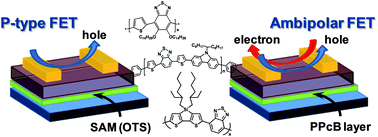Observation of ambipolar field-effect behavior in donor–acceptor conjugated copolymers†
Abstract
Although donor (D)–acceptor (A) conjugated

* Corresponding authors
a
Department of Physics and EHSRC, University of Ulsan, Ulsan 680-749, Republic of Korea
E-mail:
sucho@ulsan.ac.kr
Fax: +82 52 259 1693
Tel: +82 52 259 1268
b Department of Materials Physics, Dong-A University, Busan 604-714, Republic of Korea
c
Interdisciplinary School of Green Energy, Ulsan National Institute of Science and Technology, Ulsan 689-798, Republic of Korea
E-mail:
jykim@unist.ac.kr
d Department of Nanofusion Technology and Cogno-Mechatronics Engineering, Pusan National University, Miryang 627-706, Republic of Korea
Although donor (D)–acceptor (A) conjugated

 Please wait while we load your content...
Something went wrong. Try again?
Please wait while we load your content...
Something went wrong. Try again?
S. Cho, J. H. Seo, G. Kim, J. Y. Kim and H. Y. Woo, J. Mater. Chem., 2012, 22, 21238 DOI: 10.1039/C2JM34872A
To request permission to reproduce material from this article, please go to the Copyright Clearance Center request page.
If you are an author contributing to an RSC publication, you do not need to request permission provided correct acknowledgement is given.
If you are the author of this article, you do not need to request permission to reproduce figures and diagrams provided correct acknowledgement is given. If you want to reproduce the whole article in a third-party publication (excluding your thesis/dissertation for which permission is not required) please go to the Copyright Clearance Center request page.
Read more about how to correctly acknowledge RSC content.
 Fetching data from CrossRef.
Fetching data from CrossRef.
This may take some time to load.
Loading related content
